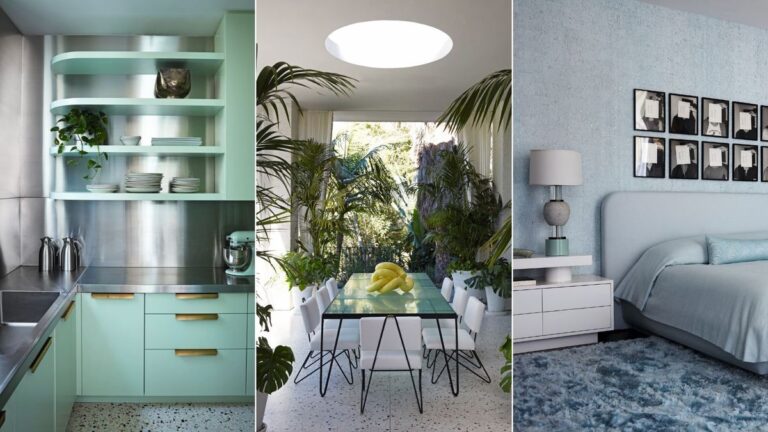Fashion designer and Swinging Sixties icon Mary Quant once said, “elegance is death, vulgarity is life,” and the owners behind this property's extraordinary residential design would probably agree.
TV presenter, model, and philanthropist Mary Kitchen wasn't interested in a posh estate nestled in the hills of her Los Angeles neighborhood. She wanted a home that was “all-out fun” rather than “understated elegance,” and when interior designer Jamie Bush was invited to join her in a bold, quirky renovation, she was thrilled.
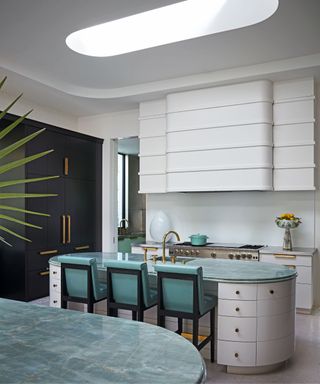
Flight, Studio Van Den Acker. Custom brass hardware, PashupatinaSink Fittings, Water SupplyEmerald green quartzite, Gem International.
(Image courtesy of Steven Kent Johnson/Otto)
Mary and her husband, Jonathan Orszag, bought the home from rock singer Adam Levine and his wife, Behati Prinsloo-Levine, who moved out mid-renovation, leaving most of the house behind.
Built in 1966 by renowned architect Kaspar Emcke, this French Regency-style mansion has grand rooms, some of which still feature vintage crystal chandeliers.
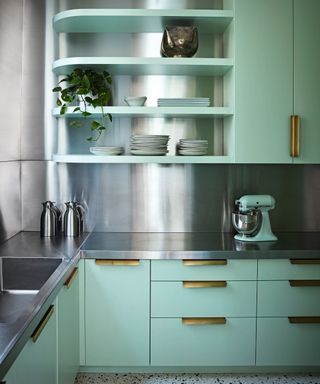
Flooring, Hermosa TerrazzoCustom cabinetry and stainless steel surfaces, Swiss woodworking.
(Image courtesy of Steven Kent Johnson/Otto)
Although Mary didn't want to lose all of the character of the original, she was keen to bring what she called “an anti-establishment flavour” to the house.
To this end, architect William Hefner modernized the building by leveling its previous sloping roof, adding contemporary eaves and windows, and replacing the original exterior stucco with reclaimed brick painted white.
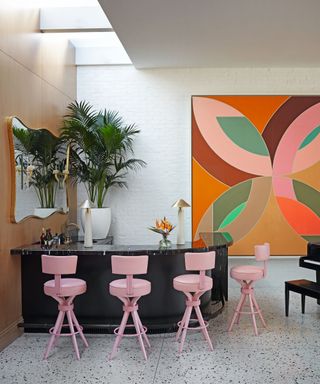
Pavoni leather stool, William Haines DesignPainting by Frank Stella.
(Image courtesy of Steven Kent Johnson/Otto)
Jamie then fused various styles together to create an opulent, throwback fantasy where Art Deco glamour and Miami Beach vibrancy met with Hollywood glamour.
“The look is completely artificial,” Jamie explains, “We started from scratch and created a new version of an old aesthetic, mixing inexpensive and premium materials.”
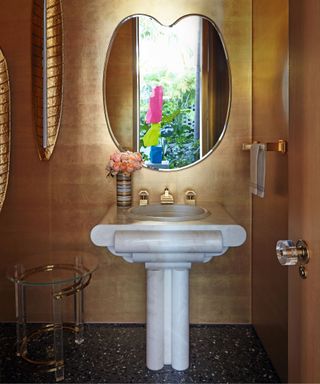
Washbasins and accessories Shalle Wagner International. Wallpaper, CalicoVintage Charles Hollis Jones side table. Mirror. Julian Chichester.
(Image courtesy of Steven Kent Johnson/Otto)
The new décor is a kaleidoscope of color: pink in the spacious living room, lilac in the dining room, pale blue in the master bedroom and teal in the kitchen/pantry.
“All the rooms are divided by colour, which is the key to allowing the different elements to coexist, controlling the different objects and themes from far-flung places and different time periods that Mary was drawn to,” says Jamie.
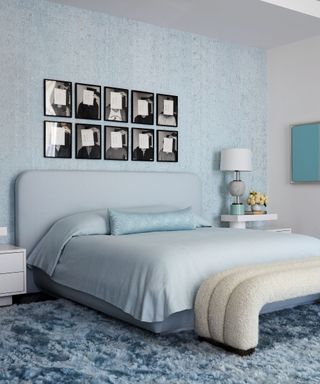
Fabric custom bed Pierre FreyVintage lamp Williams HaynesAlpaca shearling rug, Mark PhillipsArtwork by John Baldessari.
(Image courtesy of Steven Kent Johnson/Otto)
Mary's three daughters' bedrooms, as well as their bunk rooms, are covered floor-to-ceiling in fabrics, wallpapers and patterns abound. “Mary loves to push the boundaries and wanted to bring that same sense of fun into the home,” says Jamie.
He continues, “With significant art collections and bespoke furniture used throughout, the design could have been directed in a very serious way rather than with humour or joy.” Contrary to appearances, many of the elements here are new, but are made to look whimsical and retro.
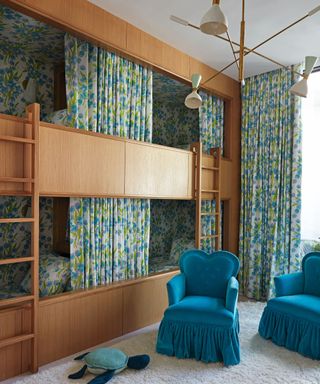
The fabric of the bunk beds and curtains Quadrillependant light, Silvio Piatelli design. Vintage fabric chair Dedar. Carpet, RH.
(Image courtesy of Steven Kent Johnson/Otto)
Jamie incorporated design trends from the 1950s and '60s, including Lucite hardware, Formica cladding and paneling, antique painted brick, and even clear plastic furniture covers, “but it's all beautifully detailed and put together,” he says.
Preserved Waterford crystal chandeliers and 19th-century Gustavian furniture are matched with Edla faux-fur chairs and bright pink leather bar stools.
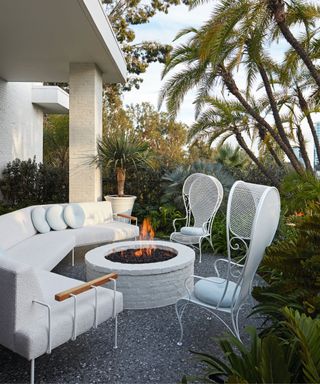
Custom sofa, Brambilla drapeBy fabric PerennialsVintage Russell Woodard wingback patio chairs.
(Image courtesy of Steven Kent Johnson/Otto)
“I love the fact that Mary embraced the concept of combining old-fashioned, traditional furniture and fabrics with key midcentury pieces and all kinds of great contemporary and kitschy pieces,” says Jamie.
“Mary pursued her vision in the most daring way. Most people wouldn't be so daring!”
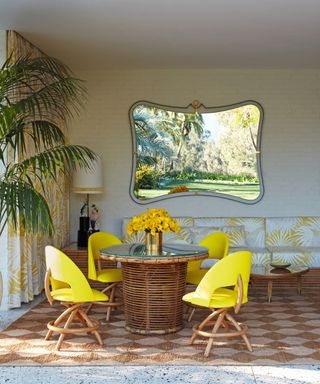
Custom made rattan chaise longue and curtains (fabric: Bob Collins & SonsVintage table, orangeVintage chair, Chairish. Custom mirrors, D&J Custom Benchworks.
(Image courtesy of Steven Kent Johnson/Otto)
Meet the designer
Jamie Bush Share your style inspiration
What is your favorite color?
Yellow has always been my northern light. My parents had a beach house in the 1960s that made a huge impression on me. It was a small, modern cabin with a bright yellow vinyl sofa, yellow Formica countertops, and matching plastic Italian tableware. As a kid, it was just magical.
Do you have any design heroes?
Ward Bennett, François Catroux, Jacques Grange.
What is your favourite piece of architecture?
If I had to choose, it would be Carlo Scarpa's Tomb of Brionne near Treviso in Italy, a most obsessive exploration of architectural detail rendered in bronze, stone and concrete.
Can you give us a secret address we should know about?
Billings is a Los Angeles-based auction house that specializes in rare midcentury furniture, so you're always sure to find something special here.
What was the last thing you bought for your home?
Designed by Alik Cavaliere circa 1990, the attractive “Genesio” chest is made from multi-colored plywood and unique, sculptural knobs.


